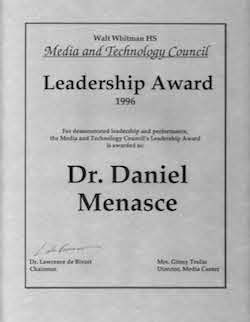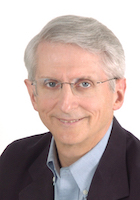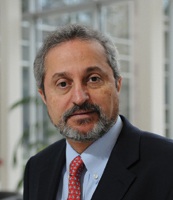by
Peter J. Denning
Daniel A. Menascé
To archived HLC site.
You are looking at the archived site of the Hyperlearning Center, which began at George Mason University (GMU) in 1993 and existed until 2002. This was the first web site to offer online competency-based learning modules (OCBMs), which have become greatly important in online education today.
In 1993, Peter Denning and Daniel Menascé at George Mason University founded the Center for the New Engineer (CNE), a center to explore new approaches to engineering education enabled by high performance computing and communications (HPCC) technologies. We published a founding document in 1993. The seminal ideas for the center are in a new framework offered in a manifesto “Educating a New Engineer” by Denning (1992). A follow-on essay “Designing New Principles to Sustain Research in our Universities” by Denning 1993] fit research into the new framework. In 1993 the US Defense Advanced Research Projects Agency (DARPA) called for proposals to bring the results of HPCC research into college curricula. We saw a way to apply HPCC technology to build online learning modules that supported the New Engineer framework by enabling nonlinear paths to demonstrated competent outcomes. Inspired by Lew Perelman (School‘s Out, Avon, 1992), we called them hyperlearning modules. We incorporated Ted Sizer‘s idea of exhibitions (Horace‘s School, Houghton-Mifflin, 1993) as a means for students to demonstrate their new skills on completing a module. We presented our proposals to DARPA program manager Tice Deyoung, who was intrigued with our ideas about hyperlearning, exhibitions, and the structure of online HPC learning support systems. We negotiated a contract for $3.2 million, which supported the CNE research program for the next four years. The web site archived here was built incrementally over that time.
The technology environment of the time was much more restricted than today. The WWW was just coming into prominence with introduction of Mosaic browser. Web pages were hand coded using HTML. The fastest computers were in the gigaops/sec range -- thus High Performance Computing meant computers of 1 gigaops/sec or faster. Home computers ran around 100 megaops/sec. Hard disks on home computers held about 20 megabytes, RAM about 1 megabyte. Data links from home to server were via modems at about 14,400 bits/sec. Only a few businesses could afford the fastest T1 (1.5 megabits/sec) Internet connections. The Internet itself was around 2 million hosts. The Internet backbone was T3 connections (45 megabits/sec). Java applets were introduced in 1995 and became the technology core of our modules and testing systems.
Our project with DARPA had three main thrusts: developing the hyperlearning idea and instantiating it as online learning modules, developing competency-based tests of student acquisition of a module‘s learning objectives, and developing a regional network in Arlington Country, VA, to connect selected K-12 schools into a regional education Internet.
A learning module was a set of text and graphic components that enabled students to follow individual paths to the learning objectives. Some paths were tailored for a particular interest. Others were simply possible ways students could follow their own interests at their own speeds. We called the learning process nonlinear to contrast with the traditional classroom following one topic each week in sequential order. We adopted the term hyperlearning because the Web-based interfaces of the modules allowed students to follow hyperlinks to access components in varying orders.
 Our student Gary Quisumbing came up with the idea of using Subway maps patterned after DC Metro and London Underground as a graphical display of nonlinear learning paths toward a learning objective. His maps featured sensitized regions around the subway stations that clicked through to the corresponding part of the module. Graphics with click sensitive areas were a novelty at the time. The click sensitive areas in the archived maps do not work today because the software that supported them on the CGI servers is no longer operational.
Our student Gary Quisumbing came up with the idea of using Subway maps patterned after DC Metro and London Underground as a graphical display of nonlinear learning paths toward a learning objective. His maps featured sensitized regions around the subway stations that clicked through to the corresponding part of the module. Graphics with click sensitive areas were a novelty at the time. The click sensitive areas in the archived maps do not work today because the software that supported them on the CGI servers is no longer operational.
We completed twelve modules by the end of the project. Eight were pure computer science, one was on the core of information technology, one on senior design projects, and two were math and statistics refreshers designed for Defense Acquisition University (DAU). The two refreshers were used by DAU for about six years until the early 2000s, when newer technologies became available.
We also designed a number of workbenches, which were simulated environments that allowed students to carry out experiments. The workbenches augmented the learning modules.
 The hyperlearning meter (HLM) was a system that tested students‘ learning. We formalized the knowledge elements into a concept map, whose structure resembled the subway map of a module, and we organized the system so that a student could monitor progress toward completing all the learning objectives of the module. Initially, all nodes of the concept map were colored red. When a student completed a test for a map element, its color would change to yellow (marginally good job) or green (completely passed). Students followed the maps until they got all the nodes green, which signified that they demonstrated all the module‘s learning objectives. Students could save their partially completed concept maps and return to them as often as desired.
The hyperlearning meter (HLM) was a system that tested students‘ learning. We formalized the knowledge elements into a concept map, whose structure resembled the subway map of a module, and we organized the system so that a student could monitor progress toward completing all the learning objectives of the module. Initially, all nodes of the concept map were colored red. When a student completed a test for a map element, its color would change to yellow (marginally good job) or green (completely passed). Students followed the maps until they got all the nodes green, which signified that they demonstrated all the module‘s learning objectives. Students could save their partially completed concept maps and return to them as often as desired.
The tests for each module section were randomized questions drawn from a large database of question templates. The instructor set up a test template that specified which questions would be presented. Each student would see a different version of the template with the questions and possible answers in varying orders, and parameters of questions randomly selected before the question was displayed. For example, an instructor could prepare a question “Is it true that a car travelling $R miles per hour will go $D miles in time =$D*3600/$R seconds?” When the question is presented to the student, the $-variables are replaced with specific values chosen at random when the question is displayed; the student might see “It it true that a car traveling at 60 miles per hour will go 2 miles in 120 seconds?”
The software that powered the HLM and the database holding the inventory of question templates are no longer operational in the archive.
 The third thrust of our work was our response to an outreach request from DARPA to help them make the hyperlearning ideas available throughout the Arlington County school system. DARPA‘s main office was (and still is) located in Arlington County, Virginia.
The third thrust of our work was our response to an outreach request from DARPA to help them make the hyperlearning ideas available throughout the Arlington County school system. DARPA‘s main office was (and still is) located in Arlington County, Virginia.
In consultation with school officials, we selected about a dozen middle and high schools across the county as well as Walt Whitman high school in Montgomery County, MD. We set them up with dedicated ISDN lines to a server at GMU running the full ARPANET protocols. We were their first experience in connecting to the Internet. After a few years, commercial ISPs took over this function.
We made the hyperlearning modules and meter system available to teachers who wanted to try those technologies in their classrooms. It turned out that most teachers‘ attentions were spent on helping their students climb the steep learning curve for working with Internet technologies.
In 1997, DARPA stopped supporting education projects because they wanted to focus more directly on research to support their military mission. We continued the partnership with DAU, doing module maintenance and designing test questions for the HLM system used by their students. The Center continued for a few more years and then we discontinued it when Denning left GMU in 2002.
When first founded, we called it the Center for the New Engineer to make the connection with the ideas of the New Engineer manifesto. The web address was cne.gmu.edu at the time. In 1995 when we were bringing the hyperlearning meter system on line we renamed the center to Hyperlearning Center and changed the web address to hlc.gmu.edu. Around 2002, the CS department at GMU reconfigured its networks and we moved the web site to cs.gmu.edu/hlc. We hope that we have detected and revised all these now defunct addresses in the archive.

Peter J. Denning is Distinguished Professor of Computer Science and Director of the Cebrowski Institute for information innovation at the Naval Postgraduate School in Monterey, California. He is Editor of ACM Ubiquity, a past president of ACM, and author of numerous books and papers, most recently Great Principles of Computing (MIT Press 2015).

Daniel A. Menascé is University Professor of Computer Science at George Mason University and Fellow of the ACM and IEEE. He is well known for his books and papers on computer system performance evaluation and has received several best paper and achievement awards for his work.
©Copyright 1994-99 by the HyperLearning Center.
All Rights Reserved.
Please read our
Copyright Notice for information on linking to or copying from our server.